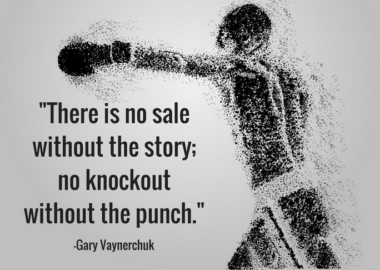Considering the future of marketing, Michael Brenner of Newscred recently predicted that storytelling “will topple other marketing silos, emerging as the ultimate audience-reaching tactic.”
While we happen to agree, it’s clear that storytelling has become, in 2015, a bit of a marketing darling.
But here’s the thing. Storytelling is a star today because it’s an incredibly powerful–and timeless–way to connect, communicate and drive change. It’s trending because brands, businesses and marketers have discovered that this powerhouse is also good strategy.
In an era when any one of us can create, publish and share anything we choose, great storytelling has become the differentiator. We’ve all consumed “content.” Yet what we continually respond to is story.
Why Businesses Need to Tell Great Stories
Pixar filmmaker Andrew Stanton famously compared storytelling to joke telling. “It’s knowing your punchline, your ending, knowing that everything you’re saying, from the first sentence to the last, is leading to a singular goal.”
The goal is the starting point for business storytelling.
Stories in general–when chosen wisely, and told well–are powerful tools for persuasion, influence, affection and trust. Even short stories, or anecdotes, can pique your audience’s interest and create emotion. They make us feel as well as think. Stories can teach, too, subtly or directly. And they create lasting pictures in your audience’s mind.
A great business story–like any great story–is memorable, persuasive, moving, engaging, immersive and surprising. And it’s usually not just about entertainment: it can delight but may also educate, and lead.
Ultimately, a great business story is a tool used to achieving results.
What, then, is your goal as a business, leader or marketer? Is it to increase sales? To generate leads? To secure investors? To educate your audience? Perhaps to influence or persuade someone in business and/or to change their behaviour?
The Core Elements of a Great Business Story
Before you tell your next anecdote, prepare your next speech or presentation, or craft your next marketing campaign, scan through this list to ensure optimal effectiveness.
Get to the point.
Even before you consider the story you’re going to tell, know the results you’re driving for. Identify the points you want to make (ideally no more than three) and include supporting detail.
Get over your conflict aversion (and check your 5 Cs Checklist).
A great story–whether presented as an anecdote, a presentation or a sales pitch–has structure. When you’re reviewing the story you’re about to tell, this checklist can help to ensure that the fundamentals are in place:
- Circumstances: Have you properly set the scene, providing the information necessary to give your audience context?
- Curiosity: Have you offered your audience a reason to care or be curious?
- Characters: Are the people or characters in your story relatable?
- Conversations: Have you included believable dialogue?
- Conflict: Does your audience have reason to hang on till the end to find out what happens?
Get emotional.
Identify the kinds of emotions you’d ideally like your audience to feel, and craft your story to hit those notes. Please don’t be afraid to share what’s real and true to you.
Find your hero.
Identify the hero of your story, whether it’s your business, a product or service, your client or audience, or a place. Give that hero a conflict to overcome (see the 5 Cs). And for the love of Pete, if the hero in your story is you, consider sharing at least as many failures as successes. Empathy and authenticity must come into play.
Prize the details.
You heard it from your English teacher in Grade 3: show, don’t tell. The more your audience feels, sees, tastes what you’re describing, the more they’re hooked.
Don’t start at the beginning.
Have you ever heard of anyone excited to hear a chronological recitation of occurrences? Try starting in the middle, where things are most exciting.
Challenge your audience.
Since you do have a purpose in telling your business story, consider ending with a question or assignment that will compel your audience to take action.
More Storytelling Fundamentals:







